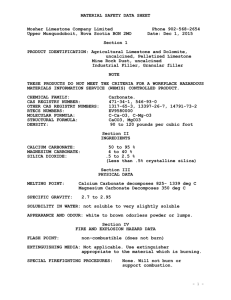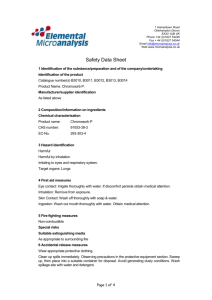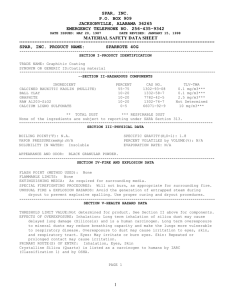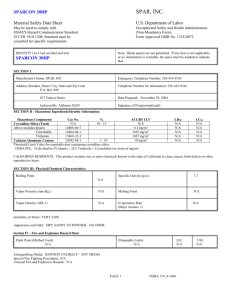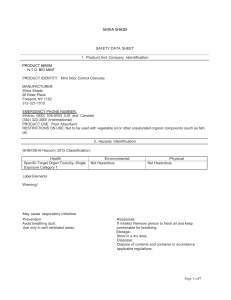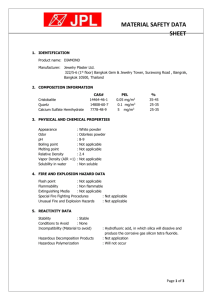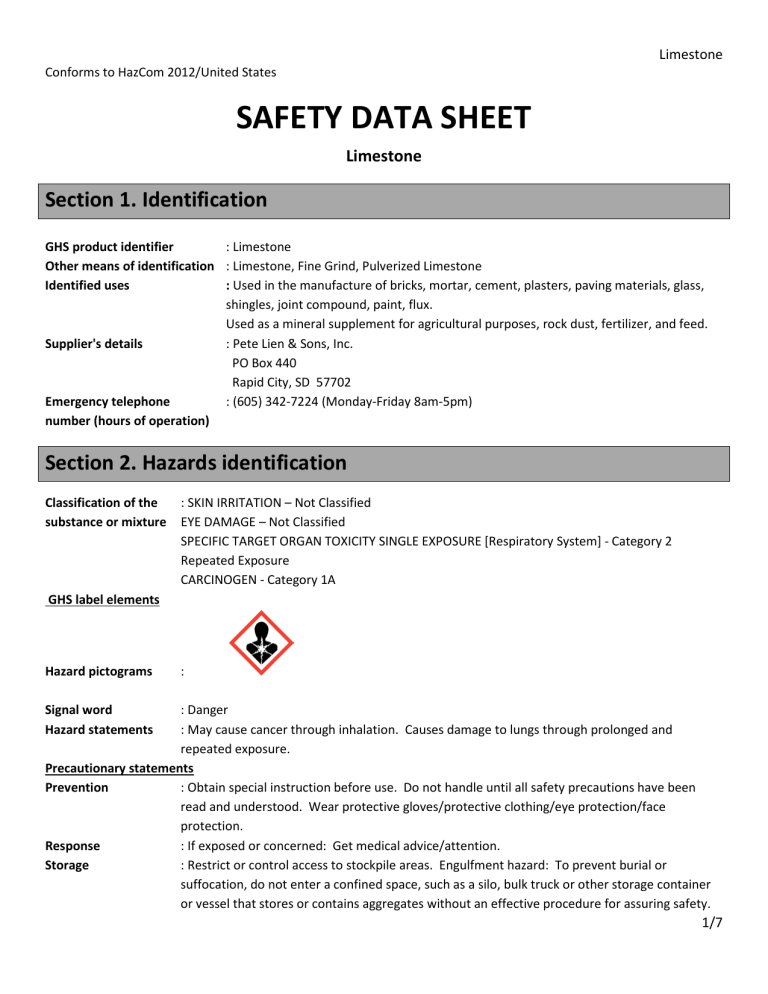
Limestone Conforms to HazCom 2012/United States SAFETY DATA SHEET Limestone Section 1. Identification GHS product identifier : Limestone Other means of identification : Limestone, Fine Grind, Pulverized Limestone Identified uses : Used in the manufacture of bricks, mortar, cement, plasters, paving materials, glass, shingles, joint compound, paint, flux. Used as a mineral supplement for agricultural purposes, rock dust, fertilizer, and feed. Supplier's details : Pete Lien & Sons, Inc. PO Box 440 Rapid City, SD 57702 Emergency telephone : (605) 342-7224 (Monday-Friday 8am-5pm) number (hours of operation) Section 2. Hazards identification Classification of the substance or mixture : SKIN IRRITATION – Not Classified EYE DAMAGE – Not Classified SPECIFIC TARGET ORGAN TOXICITY SINGLE EXPOSURE [Respiratory System] - Category 2 Repeated Exposure CARCINOGEN - Category 1A GHS label elements Hazard pictograms : Signal word Hazard statements : Danger : May cause cancer through inhalation. Causes damage to lungs through prolonged and repeated exposure. Precautionary statements Prevention : Obtain special instruction before use. Do not handle until all safety precautions have been read and understood. Wear protective gloves/protective clothing/eye protection/face protection. Response : If exposed or concerned: Get medical advice/attention. Storage : Restrict or control access to stockpile areas. Engulfment hazard: To prevent burial or suffocation, do not enter a confined space, such as a silo, bulk truck or other storage container or vessel that stores or contains aggregates without an effective procedure for assuring safety. 1/7 Limestone Disposal : Dispose of contents/containers in accordance with applicable regulations. Hazards not otherwise : None known classified Ingredients with : Not Applicable unknown toxicity Supplemental Information: Respirable Crystalline Silica (RCS) may cause cancer. Limestone is a naturally occurring mineral complex that contains varying quantities of quartz (crystalline silica). In its natural bulk state, limestone is not a known health hazard. Limestone may be subject to various natural or mechanical forces that produce small particles (dust) which may contain respirable crystalline silica (particles less than 10 micrometers in aerodynamic diameter). Repeated inhalation of respirable crystalline silica (quartz) may cause lung cancer according to IARC and NTP; ACGIH states that it is a suspected cause of cancer. Other forms of RCS (e.g., tridymite and cristobalite) may also be present or formed under certain industrial processes. Section 3. Composition/information on ingredients Substance/mixture : Calcium Carbonate CAS number/other identifiers Component CAS # % by weight Calcium Carbonate 1317-65-3 >50 Crystalline Silica (quartz) 14808-60-7 >0.1 Impurities : Small quantities of calcium carbonate, calcium oxide and impurities. Impurities will vary from source to source. Section 4. First aid measures Description of necessary first aid measures Eye Contact : Contact can cause irritation of eyes. Immediately flush eyes with generous amounts of water for at least 15 minutes. Pull back the eyelid to ensure that all limestone dust has been washed out. Seek medical attention if irritation develops or persists. Skin Contact : Wash exposed area with soap and water. Seek medical attention if irritation develops and persists. Ingestion : Rinse mouth and drink plenty of water. Never give anything by mouth to an unconscious person. Get medical attention. Inhalation : Move to fresh air. Seek medical attention if symptoms develop or persist. Most important symptoms/effects, acute and delayed : Long-term exposure by inhalation may cause permanent damage. This product contains crystalline silica, which has been classified by IARC as (Group I) carcinogenic to humans when inhaled. Inhalation of silica can also cause a chronic lung disorder, silicosis. 2/7 Limestone Indication of immediate medical attention and special treatment needed, if necessary: See first aid information above. Note to Physicians: Provide general supportive measures and treat symptomatically. Section 5. Fire-fighting measures Extinguishing Media : Substance is nonflammable; use agent most appropriate to extinguish surrounding fire. Unsuitable Extinguishing Media: None known Fire Hazards : No unusual fire or explosion hazards noted. Not a combustible dust. Hazardous Combustion Products: Calcium Oxides Special Protective Equipment and Fire Fighting Instructions: Use protective equipment and appropriate for surrounding materials. Contact with powerful oxidizing agents may cause fire and/or explosions. Section 6. Accidental release measures Personal precautions, protective equipment and emergency procedures Spill/Leak Procedures : Use proper protective equipment and clothing during clean-up of materials that contain or may liberate limestone dust. Spilled material where, where dust is generated, may overexpose cleanup personnel to respirable crystalline silica-containing dust. Avoid generating dust. Do not clean up with compressed air or dry sweep. Wetting of spilled material and/or use of respiratory protective equipment may be necessary Methods and materials for containment and cleaning up Containment : For large spills, as much as possible, avoid the generation of dusts. Prevent release to sewers or waterways. Section 7. Handling and storage Precautions for safe handling Do not handle until all safety precautions have been read and understood. Keep formation of airborne dusts to a minimum. Provide appropriate exhaust ventilation at places where dust is formed. Do not breathe dust. Avoid prolonged exposure. Provide adequate ventilation. Wear appropriate personal protective equipment. Observe good industrial hygiene practices. Conditions for safe storage, including any incompatibilities Avoid dust formation or accumulation. Section 8. Exposure controls/personal protection Exposure limits Component Calcium Carbonate CAS # 1317-65-3 Crystalline Silica 14808-60-7 Exposure limits OSHA PEL: 5mg/m3 (respirable) NIOSH TWA: 5mg/m3 (respirable) OSHA PEL: 10mg/m3 divided by (the percentage of silica in the 3/7 dust plus 2) (respirable) ACGIH TLV: 0.025 mg/m3 (respirable) Limestone Engineering controls : Provide ventilation adequate to maintain PELs. Ventilation rates should be matched to conditions. If applicable, use process enclosures, local exhaust ventilation, or other engineering controls to maintain airborne levels below recommended exposure limits. Individual Protection Measures Respiratory Protection : Use NIOSH/MSHA approved respirators if airborne concentration exceeds PEL. Skin Protection : Use appropriate personal protective equipment as required. Eye Protection : Use safety glasses with side shields or safety goggles. Other : Eye wash fountain and emergency showers are recommended Thermal Hazards : Not Anticipated. Wear appropriate thermal protective clothing, when necessary. General Hygiene : Always observe good personal hygiene measures, such as washing after handling the material and before eating, drinking, and/or smoking. Routinely wash work clothing and protective equipment to remove contaminants. Section 9. Physical and chemical properties Physical State Appearance Odor Odor threshold pH at 25 degrees C Melting point Initial boiling point Flash point Evaporation rate Flammability (solid, gas) Lower and upper explosive (flammable) limits Vapor pressure Vapor density Relative density Solubility in water Partition coefficient: n octanol/water Auto-ignition temperature Decomposition temperature Viscosity : Solid : White, tan, pink or grayish-white material : Not applicable : Not applicable : 8-10 : Not applicable : Not applicable : Non-combustible : Not applicable : Not applicable : Not applicable : Not applicable : Not applicable : 2.6-2.8 g/cc : Insoluble : Not applicable : Not applicable : Not applicable : Not applicable Section 10. Stability and reactivity Reactivity : This product is stable and non-reactive under normal conditions of use, storage and transport. 4/7 Chemical stability : Material is stable under normal conditions Possibility of : No dangerous reaction known under conditions of normal use. hazardous reactions Conditions to avoid : Acids. Ignites with fluorine. Incompatible materials : Incompatible with ammonium salts and magnesium decomposition products Limestone Section 11. Toxicological Information Information on the likely routes of exposure: See First Aid discussion above. Inhalation :Repeated inhalation of respirable crystalline silica (quartz) may cause silicosis, a fibrosis (scarring) of the lungs. Silicosis is irreversible and may be fatal. Silicosis increases the risk of contracting pulmonary tuberculosis. Some studies suggest that repeated inhalation of respirable crystalline silica may cause other adverse health effects including lung and kidney cancer. Skin Contact :Limestone dust may cause irritation through mechanical abrasion Eye Contact : Limestone dust may cause irritation through mechanical abrasion Ingestion : Not likely, due to form of the product. However, accidental ingestion of the content may cause discomfort Symptoms related to the physical, chemical and toxicological characteristics: Limestone dust: Discomfort in chest. Shortness of breath, Coughing. Delayed and immediate effects and also chronic effects from exposure: Not expected to be acutely toxic. This product is not expected to be a skin hazard. Direct contact with eyes may cause temporary irritation. No respiratory sensitizing effects known. Not known to be a dermal irritant or sensitizer. No data available to indicate product or any component present at greater than 0.1% are mutagenic or genotoxic. Numerical measures of toxicity: No LD50/LC50 have been identified for this product’s components. Carcinogen listing: Limestone is not listed by MSHA, OSHA, or IARC as a carcinogen, but this product contains crystalline silica, which has been classified by IARC as (Group I) carcinogenic to humans when inhaled Section 12. Ecological information Ecotoxicity : There is no data available. Persistence and degradability : There is no data available. Bioaccumulative potential : This material shows no bioaccumulation effects of food chain concentration toxicity. Mobility in soil : There is no data available. Other adverse effects : This material is alkaline and if released into water or moist soil will cause an increase in pH. Section 13. Disposal considerations Disposal Instructions Hazardous waste code Waste from residues/ : Do not allow fine particulate matter to drain into sewers/water supplies. Do not contaminate ponds waterways or ditches with fine particulates. Dispose of contents in accordance with local/regional/national/international regulations. : Not regulated :Dispose of in accordance with local regulations. Empty containers or liners may retain 5/7 unused product Contaminated packaging Limestone some product residues. This material and its container must be disposed of in a safe manner (See disposal instructions) : Since emptied containers may retain product residue, follow label warnings even after container is emptied. Empty packaging materials should be recycled or disposed of in accordance with applicable regulations and practices. Section 14. Transport information DOT IATA IMDG Transport in bulk according to Annex II of MARPOL 73/78 and the IBC Code :Not regulated as dangerous goods :Not regulated as dangerous goods :Not regulated as dangerous goods : Not applicable Section 15. Regulatory information US Federal Regulations :This product is a “Hazardous Chemical” as defined by the OSHA Hazard Communication Standard, 29 CFR 1910.1200. TSCA Section 12(b) Export Notification (40 CFR 707, Subpt. D)-Not Regulated OSHA Specifically Regulated Substances (29 CFR 1910.1001-1050-Not Listed CERCLA Hazardous Substance List (40 CFR 302.4)-Not Listed Superfund Amendments and Reauthorization Act of 1986 (SARA) Hazard Categories Immediate HazardNo Delayed HazardYes Fire HazardNo Pressure HazardNo Reactivity HazardNo SARA 302 Extremely hazardous substance-Not Listed SARA 311/312 Hazardous chemical-Yes SARA 313 (TRI reporting)-Not regulated Other federal regulations Clean Air Act (CAA) Section 112 Hazardous Air Pollutants (HAPs) List-Not regulated Clean Air Act (CAA) Section 112(r) Accidental Release Prevention (40 CFR 68.130)-Not regulated Safe Drinking Water Act (SDWA)-Not regulated Section 16. Other information History Date of issue (mm/dd/yyyy) Version : 06/01/2015 :1 Disclaimer: The information contained in this document applies to this specific material as supplied. Pete Lien & Sons, Inc. believes that the information contained in this SDS is accurate. The suggested precautions and recommendations are based on recognized good work practices and experience as of the date of publication. They are not necessarily all- 6/7 Limestone inclusive or fully adequate in every circumstance as not all use circumstances can be anticipated. The suggestions should not be confused with nor followed in violation of applicable laws, regulation, rules or insurance requirement. It is the user’s responsibility to satisfy oneself as to the suitability and completeness of this information for one’s own particular use. Since the actual use of the product described herein is beyond our control, Pete Lien & Sons, Inc. , assumes no liability arising out of the use of the product by others. Appropriate warnings and safe handling procedures should be provided to handlers and users. Product must not be used in a manner which could result in harm. 7/7
